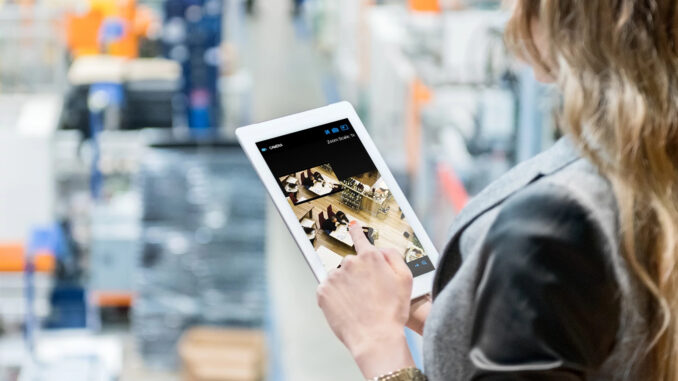
By Scott Thomas, National Director, Signature Brands for Genetec - 7.14.2022
Restaurant chains rely on physical security systems to keep customers and employees safe and operations secure. Historically, this includes video surveillance with on-premises storage and monitoring. While this may be adequate to manage security at one location, it can limit the ability to manage security across multiple sites.
Cloud-based or hybrid solutions provide a way for restaurant chains to oversee and monitor multiple sites from a single location. A centralized control center based on a cloud or hybrid system provides a way for restaurant operators to identify widespread issues and resolve them more efficiently. Security managers can gather regional data for an investigation or identify supply chain deliveries at different locations. Cloud-based systems can even be used to improve general business operations and drive growth.
Using the cloud for more than business processes
While cloud-based or hybrid systems might have been considered out of the ordinary at one point in time, software-as-a-service (SaaS) models have become more commonplace in the restaurant industry. Many processes such as point-of-sale, online ordering, and payroll have moved to the cloud. SaaS installations have accelerated even further during the last few years, as demand for remote services increased. Chains that adopted cloud models often reap benefits from less costly IT management, protected data backups, faster technology updates, and other economies of scale.
While chains have often adopted cloud-based solutions to handle many business functions, they’ve been more hesitant to adopt similar solutions for security operations. Security systems that include multiple cameras, access points, and storage devices can make the transition to a new cloud or hybrid system feel more complex and daunting. However, an open architecture cloud-based physical security system can often work with existing cameras and IoT devices, making the transition easier and more manageable. SaaS models exist for video surveillance, access control, centralized video monitoring, shared video storage at data centers, and other physical security applications.
Cloud and hybrid solutions provide robust and affordable IT capabilities
Cloud-based computing allows restaurant chains to use today’s more capable physical security systems with a less substantial investment in infrastructure. Cloud and hybrid solutions can help reduce expenses for servers, IT and security staff, wiring, heating and cooling or equipment, and software installations and updates, which can all add up to significant investments. Updates and patches that enhance cybersecurity can also be pushed through the cloud to keep a system current with the latest features and functionality. This can deter cyberattacks and maintain customer data safer, thus reducing the potential expense of investigating and correcting an attack on the system.
SaaS solutions also allow organizations to deploy surveillance systems for a cost-effective and consistent monthly fee. This helps alleviate the need for approvals and sourcing of lump-sum capital expenditures to procure more on-premises servers as video storage demands grow. A flexible, scalable cloud storage solution can expand as your needs grow.
Cloud solutions can help chains save costs in other ways too. For example, instead of re-keying locations by updating physical locks after a security incident, a cloud-based system enables restaurant chains to re-key multiple locks in different locations digitally from one central location. This can save significant expense when dealing with hundreds or thousands of sites. Travel costs are also reduced when security managers monitor operations remotely. They can reduce travel to individual locations when assessing security operations or gathering evidence for a case.
Gain better insights for operational efficiencies and improvement
A unified, cloud-based system for video surveillance and monitoring allows security managers to visualize issues at a glance and review video footage from any location to see the details of a security event, operational improvement opportunity, or potential risk. By understanding issues more quickly and comprehensively, managers can act promptly to correct them.
In the event of theft, vandalism, or fraud, restaurant operators can use a cloud or hybrid system to collect, manage, and share video evidence and other case information confidentially. A unified, cloud-based system for evidence sharing provides a comprehensive audit trail that ensures the chain of custody of evidence is always maintained to support investigations. Centralized monitoring can also verify that all cameras and devices are working properly and fully compliant. An alert can identify when a device is offline so it can be replaced quickly to avoid gaps in coverage.
Surveillance video helps regional and corporate management act on other business improvements too, such as those related to food safety, customer data protection, and customer satisfaction. Are the tables cleaned correctly? Are storage boxes blocking exit doors in the kitchen? Did supply chain deliveries expose the business to food safety issues?
Customer satisfaction can be improved through video analysis to determine common customer patterns. Chains can see when customers congregate in the bar versus the restaurant or whether staffing is appropriate at peak times. This information can then be shared and analyzed to help the restaurant management team make informed decisions about how they can improve their operations.
Start where you are
Open architecture is the key to starting with cloud-based security solutions. A SaaS system with open architecture often supports existing cameras and other equipment, so you can build out cloud solutions gradually using current equipment and adding additional cloud components that best fit your needs. You can start with a hybrid cloud solution that allows the use of on-premises video storage with cloud-based monitoring. Over time, you can transition to a fully cloud-based system with video stored directly to the cloud.
By incorporating a cloud-based or hybrid cloud solution, businesses of any size can reduce investment in new hardware and scale computing and storage resources to facilitate physical security at multiple locations. Ongoing IT network infrastructure expenses such as purchasing servers, electricity, and cooling can be drastically reduced if not eliminated.
Cloud solutions for surveillance and monitoring help restaurant chains improve their security management, as well as overall operations. By turning to the cloud, chains can stay safer and more connected, accessing the latest technologies to support their growth and enhance their operations.
 Scott Thomas is National Director, Signature Brands for Genetec in the United States. Genetec is an innovative technology company with a broad solutions portfolio encompassing security, intelligence, and operations. The company’s flagship product, Security Center, is an open-architecture platform that unifies IP-based video surveillance, access control, automatic license plate recognition (“ALPR”), communications, and analytics.. He and his team are responsible for sales to the retail, financial, hospitality, gaming and cannabis vertical markets via Genetec’s network of system integration partners. He started his career at Genetec in 2007.
Scott Thomas is National Director, Signature Brands for Genetec in the United States. Genetec is an innovative technology company with a broad solutions portfolio encompassing security, intelligence, and operations. The company’s flagship product, Security Center, is an open-architecture platform that unifies IP-based video surveillance, access control, automatic license plate recognition (“ALPR”), communications, and analytics.. He and his team are responsible for sales to the retail, financial, hospitality, gaming and cannabis vertical markets via Genetec’s network of system integration partners. He started his career at Genetec in 2007.
Are you an industry thought leader with a point of view on restaurant technology that you would like to share with our readers? If so, we invite you to review our editorial guidelines and submit your article for publishing consideration.

